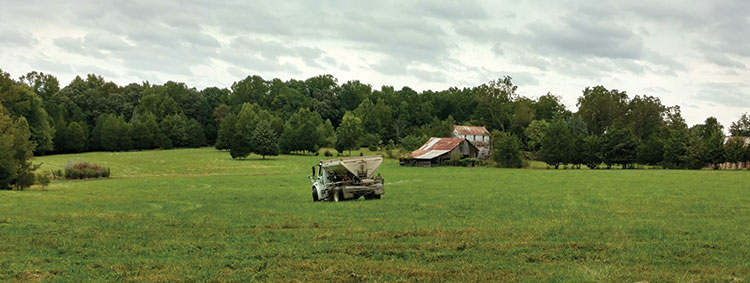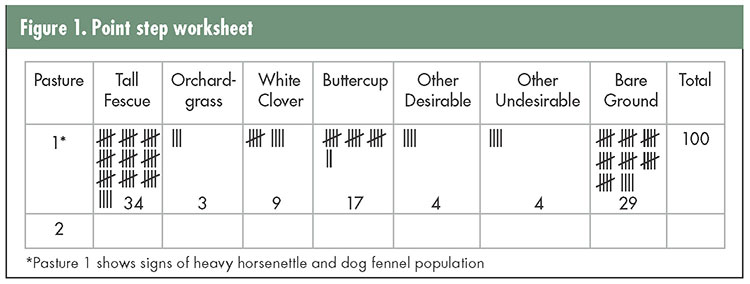
Healthy pastures are the key to efficiently feeding beef cattle in the humid regions of the United States. But, despite our efforts to do everything right, stands of most forages will eventually start to thin. This may be due to errors in your forage allocation that lead to overgrazing, letting fertility slip, or because some weed or another takes hold and competes with the desirable plants. The environment may also be to blame as severe drought, severe wet conditions leading to pugging (deep trampling), or flooding can all hurt stands.
In my area, there are many examples of good forage managers that have very nice pastures, and in the case of Kentucky-31 tall fescue, or bermudagrass, many pastures have persisted for over 50 years. Unfortunately, during the last five years the stresses listed above — too dry, too wet, or completely underwater — have taken a toll on even the pastures with the best management.
The Amazing Grazing program in North Carolina has been collaborating with other state and federal agencies to support pasture renovation by providing new no-till drills in counties where they are needed and to fund educational demonstrations across the state. These activities have led to a lot of discussion on how to best approach a renovation, and I will share some of that thought process here.
Find the cause
The first step in any renovation is to soil test and improve any fertility limitations identified. You should do a soil test at least every three years as part of your maintenance plan. Getting fertility right (especially pH, phosphorus, and potassium) is the first step no matter which way you go with renovation.
The second step is to identify why the pasture needs to be renovated. If overgrazing is the issue, then improving grazing management will be a key to success. If flooding or drought was the issue, then selecting species or varieties that will be more resilient to future challenges is advised.
Take inventory
It is important to get an objective idea of what the stands are like in each pasture you are thinking about renovating. We find the “point step” approach very useful for this evaluation. To do a point step, take a clipboard with a paper record form like the one shown in Figure 1. Randomly walk the pasture like you would take a soil sample, and every so often (20 to 30 steps depending on the size of the pasture) look down at your shoe tip and put a mark for whatever plant (or bare ground) your shoe tip touches. It is a little humbling to do this as it requires you to be able to identify most of the plants out there.

If you are unfamiliar with the major species, ask an adviser with experience to accompany you. Shoot for between 100 and 200 points, and then calculate a percentage of each species. Also, make notes if you find remnants of old weeds, and note gully erosion and anything else unusual you see. Continue this process on all the pastures you want to improve.
Next, interpret the results. Do you have at least 50 percent in desirable species and few very undesirable weeds?
If so, then an herbicide, fertility, and rest strategy might be all that is called for. You might consider overseeding the pasture with desired species and varieties you want or frost seeding clovers or grasses.
What are the major weed species that need to be controlled?
If less than half the points are desirable, then we would suggest killing the existing stand and planting an improved variety of a species that will complement your forage system. This might be a native warm-season grass, bermudagrass (or another warm-season perennial), novel endophyte tall fescue, or some other niche forage. There are many options, and the renovation process is a chance to upgrade your forage system to use new and improved genetics.
If you do decide to fully renovate, study the species you want to plant and establish them at the recommended time. If this is more than a month or two in the future, we would recommend that you terminate the existing stand and plant an annual smother crop to suppress weed populations, prevent soil erosion, and to break up surface compaction and very dense sod.
Let it establish
Once you do get to planting, start with good quality seed, calibrate your drill, get the seed depth right, and make sure there is not too much surface residue to prevent good seedling emergence. Also, do your best to avoid gaps and skips . . . these become a place for weeds to establish. It takes a little extra seed, but overlap is a lot better than gaps!
Once the stand is up, make sure you baby it for the establishment year. Don’t graze under wet or dry conditions and be very careful not to overgraze. If adding clovers, we recommend frost seeding in February following an autumn grass planting.
The establishment phase needs to continue for the first full growing season. Be very careful not to overgraze, and scout for weeds and treat them before they hurt the new stand. If you expect weeds, you might want to wait to put out clover until the second year so you have flexibility to use an herbicide.
Because your effective yields will likely be lower for the year following a full renovation, it is important to reduce stocking rate some or to bring in additional feed resources. Because of this, it makes the most sense to do no more than 10 to 20 percent of the farm in any given year to prevent a large drop in forage production.
Get more bang for the buck
A final point is that the most benefit will come with the pastures that need to be renovated the most. Renovating pastures with poor stands of desirable forages and high weed populations will give you the best bang for your buck. Upgrading your most productive pastures will not give you nearly the yield benefit and will cost you more on lost forage production.
Pasture renovation is an important process that should be embraced by all pasture-based livestock farmers. There are many opportunities to learn more about pasture renovation. Included are trainings on renovation with novel endophyte fescue provided by the Alliance for Grassland Renewal. Dates are March 10 in Middleburg, Va.; March 12 in Mt. Ulla, N.C.; March 16 in Athens, Ga.; March 18 in Springhill, Tenn.; March 19 in Lexington, Ky.; March 24 in Harrison, Ark.; and March 25 in Mt. Vernon, Mo.
This article appeared in the January 2020 issue of Hay & Forage Grower on pages 6 and 7.
Not a subscriber? Click to get the print magazine.

